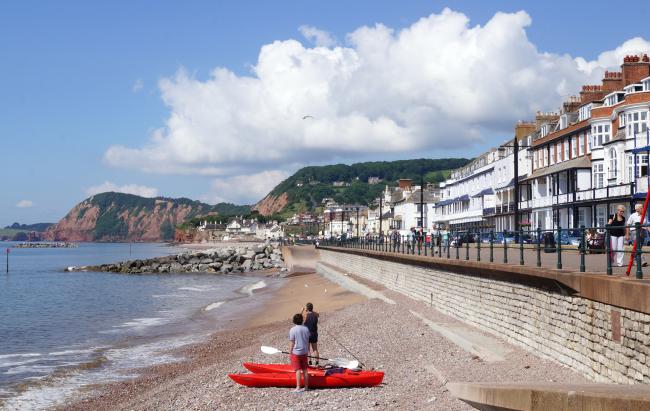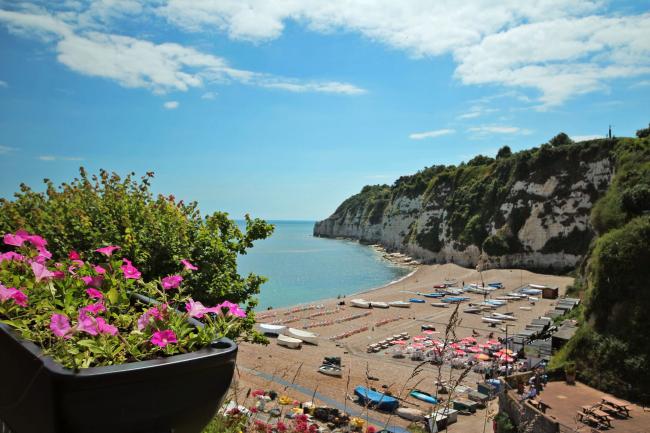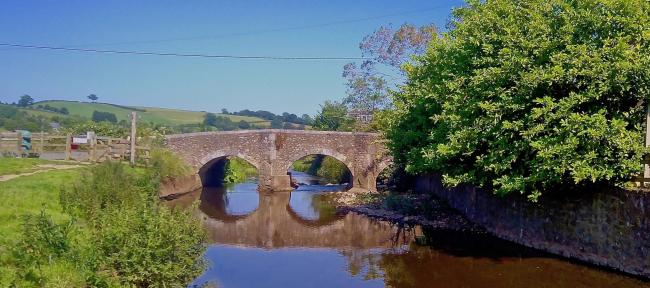
Explore The East Devon Way and Fall in Love With Holidays in Devon
Why Choose a Holiday in East Devon?
East Devon is known for its picturesque coastline, softly rolling hills and beautiful beechwoods lined with carpets of bluebells in spring. So, unsurprisingly, it is a designated National Landscape that offers many an opportunity to enjoy glorious vistas of idyllic countryside and coastline.
It’s an area of slumbering villages full of thatched cottages, historic churches, towering Jurassic Coast cliff-top vistas, deep flower-lined lanes, and wiggly footpaths. There are plenty of holiday cottages throughout the green and verdant countryside, from shepherd huts offering romantic rural retreats to large country houses, perfect for big family gatherings, reunions and celebrations. For those who enjoy an active holiday exploring the area, there’s no better way to sample the delights of this corner of Devon than to walk the East Devon Way. This is a 40-mile long, primarily coastal route that takes in eight villages and crosses five rivers.
So, if you’re planning a self-catering holiday with plenty of walking options, a beach or two for a lazy swim or paddle, pubs and tea rooms plenty and a gorgeous country cottage to return to after a day’s labour in the sun, then a self-catering holiday exploring the East Devon Way is one for the holiday bucket list.
We’ve put together not so much of an itinerary but a list of places to visit and things you can do, see and enjoy in the various towns and villages along the route (including tea rooms and pubs). You can walk, cycle or drive from one location to the other. It’s not an exhaustive list – just enough suggestions to fill a memorable weekend or week’s holiday in this not-so-crowded corner of Devon.
EXMOUTH
The East Devon Way starts at the coastal town of Exmouth, the largest of East Devon’s seaside resorts and fishing villages. It has a beautiful sandy beach backed by a promenade perfect for swimming, sandcastles, beach games and water sports. There is good rock pooling beneath Orcombe Point at the eastern end at low tide, while nearer the centre of town, the RNLI’s lifeboat station is a fascinating place to look around.
Al La Ronde: If you want to linger in Exmouth, visitors will enjoy a look around the 18th-century A La Ronde, a unique 16-sided house with walls featuring beautiful shell mosaics. It is owned by the National Trust and open to the public.
The Exmouth Museum: Located on the seafront, this small museum tells the story of Exmouth’s intriguing history, from its fishing and boat-building heritage to its fascinating role in World War II.
Exmouth Fun Park: This amusement park is located on the seafront and offers a range of rides and attractions for all ages.
Exmouth Pavilion: This entertainment venue hosts a range of events, from live music to theatre productions.
Orcombe Point: This is the start of the Jurassic Coast, a UNESCO World Heritage Site that stretches for 95 miles along the coast of Dorset and East Devon.
South West Coast Path: The South West Coast Path runs along the entire length of the Devon coastline, including Exmouth Beach and Promenade. It offers stunning views of the sea, cliffs, and beaches.
Exmouth Marina: This modern marina is home to a range of boats and yachts and is a great place to take a stroll and enjoy the views.
Phear Park: This beautiful park is located just a short walk from Exmouth Beach and Promenade and offers a range of activities, including a play area, tennis courts, and a bowling green.
BUDLEIGH SALTERTON
Located on the coast in the East Devon Area of Outstanding Natural Beauty, this charming town has a beautiful beach and a pebble ridge. Pause for a while to listen to the hypnotic rhythm of waves crashing onto the shore and the rattle of pebbles as the water is sucked back into the ocean. The cliffs at either end of this little East Devon seaside town are all part of the South West Coast Path and offer stunning views overlooking Budleigh, its beach and the Atlantic Ocean. Visit The Fairlynch Museum from the beach, where Jane Austin used to stay (long before it became a museum). The Museum houses a collection of exhibits that tell the story of the town's history and heritage. Also, within the picturesque town is a healthy choice of tearooms and restaurants. We recommend Tea and Tittle Tattle on the High Street, The Creamery on Fore Street, which has a lovely courtyard garden and The Green Door, a vegetarian and vegan café on Station Road. Budleigh has some lovely bookshops to browse as befitting its connections with the writer Jane Austin. These include The Temple Bookshop, housed in a beautiful 14th Century Temple and sells second-hand books, and The Budleigh Literary Festival Bookshop, which sells books written by writers who have appeared in past Budleigh Literary Festivals (a must-go visit in mid-September).
EAST BUDLEIGH
Often overlooked by visitors to Budleigh Salterton, East Budleigh is a small, pretty village in the heart of the East Devon countryside. It is the birthplace of Sir Walter Raleigh. The village has a pub with a lovely beer garden called, appropriately enough, The Sir Walter Raleigh Pub. Take time to explore the beautiful 12th-century church and admire the many thatched cottages.
Bicton Park Botanical Gardens is a stunning 60-acre garden just a few miles east of East Budleigh. It’s family-friendly, too, offering a range of attractions within the gardens, including a fabulous glasshouse, a train ride, and a play area.

OTTERTON
This picturesque village is located on the banks of the gently flowing River Otter. Otterton has a beautiful 13th-century church worth exploring and several thatched cottages. Be sure to visit the main attraction: Otterton Mill, a historic, working watermill which offers a range of attractions, including a bakery, a shop, and an excellent restaurant. If you decide not to eat at The Mill, head for The Kings Arms, which serves refreshing local ales and seriously good pub food.
SIDMOUTH
This charming Regency seaside town has a lovely promenade overlooking a sandy beach that runs along the seafront and offers stunning coastline views. Beyond the western headland is Jacobs Ladder Beach, so named because, at one time, the only way down to it was by a long ladder. Nowadays, it can also be accessed by a snaking ramp. It’s a superb, family-friendly place for beach picnics and paddling. Visit Sidmouth in Early August, and you’ll stumble into one of the UK’s most popular folk festivals, which takes place in little venues and marquees throughout the town. Expect to find more Morris Dancers than walkers on the Promenade when the sun is shining!

SALCOMBE REGIS
Salcombe Regis is a small coastal village with a beautiful church dedicated to St Mary and St Peter and several thatched cottages.
Between Sidmouth and Branscombe, the coast path mainly follows the coast path and has little side paths leading down to deserted part-sand, part-shingle beaches at Weston Mouth and Littlecombe Shoot. They are known locally as ‘The Secret Seaside’. You won’t need walking boots and the paths are not for little legs. But, for intrepid lovers of empty beaches, they are worth the trek down to the waves. These beaches are dog-friendly all year round for those on holiday with their dogs.
BRANSCOMBE
This long and picturesque village lines a picturesque Devon valley reaching down to the sea. It does have two good pubs, The Fountain Head at the top of the village and the ultra-foodie Masons Arms in the centre. You can walk inland to the centre of the village via a delightful footpath through fields. In summer, its tiny cottages are decorated with a multitude of flowers as the village seeks to notch up another Britain in Bloom Award. At its heart, Branscombe has a still-working, thatched Smithy (watch the blacksmiths at work) and a National Trust tearoom in the old village bakery. If you want to stick to the coast, don’t worry; the Sea Shanty Beach Café & Shop (another thatched building) will cater for everything you need for a day on the beach at Branscombe. There is a large pay-and-display car park at the beach for those arriving by car.

BEER
A rushing brook hurtles alongside the main road through Beer to the sea in an idyllic, sheltered cove. Colourful fishing boats are frequently found at rest on the pebbly beach where, from spring to early autumn, self-drive motorboats can be hired for an hour or two chuntering around the cove or a spot of mackerel fishing. While cream teas are available in many tea rooms in Beer, augment these with a fresh crab sandwich that probably came ashore in the morning’s catch that was landed on the beach.

SEATON
Seaton is a seaside town at the mouth of the River Axe. It has a beautiful beach and a long promenade along the seafront. The Seaton Wetlands is a nature reserve on the River Axe Estuary. It offers a range of habitats, including mudflats, salt marshes, and reed beds. It is home to a variety of bird species, including the rare Cetti’s warbler. It’s a lovely place for a walk, or you can glide slowly along its fringes on the top deck of vintage trams of The Seaton Tramway, which runs through the estuary from Seaton inland to Colyton on a restored railway line to Colyton, home to a variety of birds, insects, and other wildlife, and offers stunning views of the surrounding countryside.
COLYTON
You can put on a lot of weight in Colyton! One of the larger villages on the East Devon Way, Colyton offers a gentle riverside walk and two wicked traditional cream tea rooms: The Tramstop Café at the terminus of the tramway and Merchant Bistro and Tea Room in the marketplace. Just outside the village is Blackbury Honey Farm, a fascinating working honey farm (with another scrumptious tea room within a wildflower garden). Colyton’s other main attraction, apart from its quaint streets, is the 12th Century church of St Andrew, which, given the size of the village, is almost cathedral-like in scale and architectural merit.

AXMOUTH
Axmouth is a riverside harbour village on the River Axe with a plethora of Elizabethan cottages and farmhouses clustered around the 12th-century Church of St. Michael. For sustenance, The Ship Inn, The Kings Arms, and the Harbour Inn all offer enticing menus.
After Axmouth, having come this far along the East Devon, follow the route to its Eastern end at Lyme Regis. It's only just across the Devon border in Dorset.
Where to Stay in East Devon
Click on the title above to view our complete collection of delightful East Devon holiday cottages, including those in its larger towns and villages that are not mentioned in this blog.